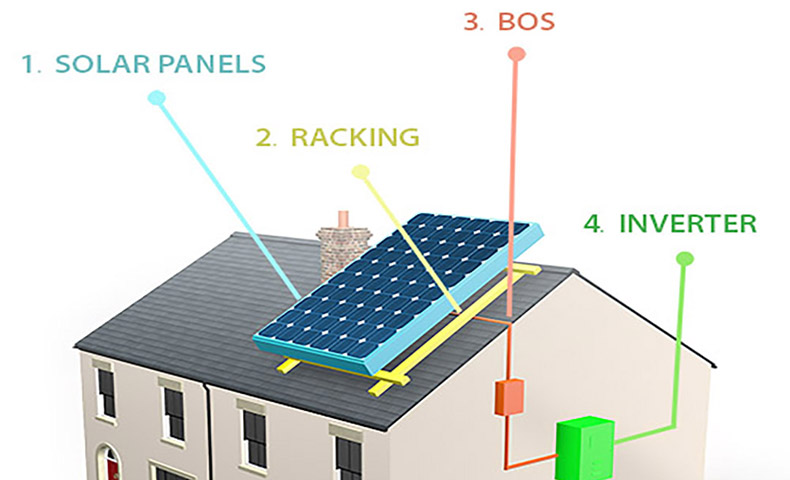
Despite technological advances, the basic composition of a residential solar power system is pretty much the same as it was 10 years.
There are some additional items that can improve monitoring and power output of a solar array, and can add additional dollars to the setup. Your budget and energy needs will dictate if you should consider them in your situation.
But let’s start with the solar basics.
The panels
A photovoltaic (PV) system begins with the solar panels or modules. The ever-increasing power output of modules helps to reduce the number needed for a kilowatt - the unit of measure to calculate electricity needs in a home.
Each panel is made up of solar cells that are linked together to produce watts. The first solar cell was made of silicon. Built by Bell Laboratories, it came into existence in 1954.
Depending on your power usage and the higher the wattage for each module, more or fewer panels will be needed to power your home.
According to the PVWatts Calculator, a 5 kW residential system - the standard size - in Los Angeles will produce about 8,306 kWh/year and will save you about $1,081 in your electric bill. To achieve the 5kW, you will need approximately 17 300-watt panels or 20 250-watt panels.
The panels are laid out next to each other in what is called an array on top of racking that separates them from the roof for a few inches. This facilitates the flow of air underneath, which helps to keep them cool as the modules absorb sunlight and convert it to DC (direct current) electricity.
Then there is the wiring, which brings us to the power electronic components needed. Different technologies vary widely in regards to the number of components in a system.
Inverters
That number depends in large part to the kind of inverters used in your solar power system.
Inverters are the brains and workhorse of the setup, transforming DC power into AC (alternating current) electricity - which your appliances use.
You can have a string inverter where all the panels in the array are linked together in a string of wires that send the energy to a single unit that makes that conversion. Or you can have microinverters that go on the back of every panel and make that conversion at that very point.
There are also DC optimizers, small devices that also attach to every module arranged in a string, boosting the energy generated by the panels.
Depending on your choice of inverters, your system could have more than 20 components or less than five. This is something to discuss with your solar panel installer, so he can offer the best advice based on your situation.
New requirements also call for a Rapid Shutdown Box, that is next to the string inverter. This device allows for power to be cut off completely in the system, helping first responders in case of fires or other emergencies.
There is also a power meter or net meter to calculate how much power you’re getting from the electric grid when your panels are not getting energy (at night) and how much of your extra electricity you’re sending to the grid when they are producing at maximum capacity.
Every component of a system has a price tag. Thus, a higher number of components results in higher initial cost.
Once the hardware is in place, the other side of the equation for a solar system are labor costs for installation, which represents about 15-20% of the initial cost.
It takes on average about 35 days from the moment you start researching and negotiating a solar power system to the moment when it is set up and turned on.
For an easy view of how much it will cost you to get solar power on your home, you can access the Hahasmart price checker, that gives you this information in a matter of seconds by simply using your address and average monthly utility bill. They’ll recommend what the correct solar power system is for your home to offset those electricity costs, the total cost of equipment and even an estimated cost of installation of your solar panels.
Off the grid
Most urban solar power systems are grid-tied, meaning there is a connection to the utility. A properly sized solar power system will usually produce more electricity when the sun is shining then the system’s loads require. The extra energy is sent to the grid, in exchange for credits.
But if you’re in a rural area, you might want to go off the grid. For this, you will need a battery to store the power produced by your solar panels during the day. Batteries capable of storing enough power to supply your entire house are still quite expensive and can double the price of a solar power system, but they are still an option for those interested in relying solely on the energy they produce.
HahaSmart Blog - More Solar Tips and Guide
HahaSmart News - Stay Informed
Your Solar Incentives - See Credits and Incentives in Your Area
Check Your Home's Solar Price - See How Much You Save
Register Now - Unlock The Lowest Solar Prices in Your Area


Input your address to see if it is solar friendly and how much you can save with solar.
Great. Your address is perfect for solar. Solar incentive is still available. Select monthly utility cost and calculate the size of solar system you will need now.
| kw System size | years Payback period | Lifetime savings |
No money down, 100% finance is available.
|
|
Check the price of solar panels in your area in a matter of seconds! |
Comments